
The Dayak or Dyak or Dayuh are one of the native groups of Borneo. It is a loose term for over 200 riverine and hill-dwelling ethnic groups, located principally in the central and southern interior of Borneo, each with its own dialect, customs, laws, territory, and culture, although common distinguishing traits are readily identifiable. The Dayak were animist in belief; however, since the 19th century there has been mass conversion to Christianity as well as Islam due to the spreading of Abrahamic religions.

West Kalimantan is a province of Indonesia. It is one of five Indonesian provinces comprising Kalimantan, the Indonesian part of the island of Borneo. Its capital and largest city is Pontianak. It is bordered by East Kalimantan and Central Kalimantan to the east, the Malaysian state of Sarawak to the north, and the Pacific Ocean to the west and the Java Sea to the south. The province has an area of 147,307 km2, and had a population of 4,395,983 at the 2010 Census and 5,414,390 at the 2020 Census; the official estimate as at mid 2022 was 5,541,376. Ethnic groups include the Dayak, Malay, Chinese, Javanese, Bugis, and Madurese. The borders of West Kalimantan roughly trace the mountain ranges surrounding the vast watershed of the Kapuas River, which drains most of the province. The province shares land borders with Central Kalimantan to the southeast, East Kalimantan to the east, and the Malaysian territory of Sarawak to the north.
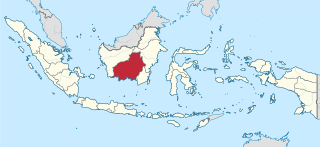
Central Kalimantan is a province of Indonesia. It is one of five provinces in Kalimantan, the Indonesian part of Borneo. It is bordered by West Kalimantan to the west, South Kalimantan and East Kalimantan to the east, Java Sea to the south and is separated narrowly from North Kalimantan and Malaysia by East Kalimantan's Mahakam Ulu Regency. Its provincial capital is Palangka Raya and in 2010 its population was over 2.2 million, while the 2020 Census showed a total of almost 2.67 million; the official estimate as at mid 2022 was 2,741,075.

Being an indigenous tribe in Borneo, the Kayan people are similar to their neighbours, the Kenyah tribe, with which they are grouped together with the Bahau people under the Apo Kayan people group. The Kayan people are categorised as a part of the Dayak people. They are distinct from, and not to be confused with, the Kayan people of Myanmar.
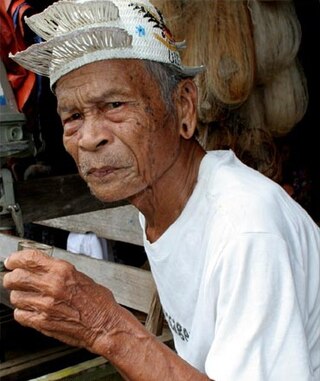
Punan Bah or Punan is an ethnic group found in Sarawak, Malaysia and in Kalimantan, Indonesia. The Punan Bah people are distinct and unrelated to the semi-nomadic Penan people. Their name stems from two rivers along the banks of which they have been living since time immemorial. They have other names including Mikuang Bungulan or Mikuang and Aveang Buan but those are used only ritually nowadays.
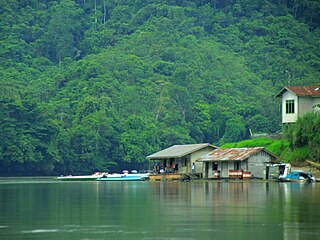
Kayan Mentarang National Park is a densely forested national park located in the Indonesian province of North Kalimantan, on the island of Borneo. The national park is named after a great dispersed Mentarang mountain trails plateau of Apau Kayan which covers the entire park from Datadian area in south region to Apau Ping area in mid region until Long Bawan in north region.
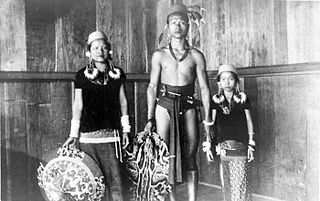
The Kenyah people are an indigenous, Austronesian-speaking people of Borneo, living in interior North and East Kalimantan, Indonesia and Sarawak, Malaysia.
Sarawak's population is very diverse, comprising many races and ethnic groups. Sarawak has more than 40 sub-ethnic groups, each with its own distinct language, culture and lifestyle. This makes Sarawak demography very distinct and unique compared to its Peninsular counterpart. However, it largely mirrors to other territories in Borneo - Sabah, Brunei and Kalimantan.

Niabor is a curved sword from Borneo, a characteristic weapon of the Sea-Dayaks.

Jimpul is a traditional weapon of the Sea Dayak and Kenyah people from Borneo. It is often thought that the Parang Jimpul may be considered as a hybrid between the Mandau and Langgai Tinggang. The Parang Jimpul is an intermediary form between the Mandau and the Langgai Tinggang dating from c. 1870-c. 1885.

The Pandat is the war sword of the Dayak people of northwest Borneo and is never used as a tool. On October 18, 2016, this weapon was featured in season 3 episode 9 of the American bladesmithing competition series Forged in Fire.

Parang Chandong is a traditional chopper used by the Dayak people of the Baram River in Borneo.
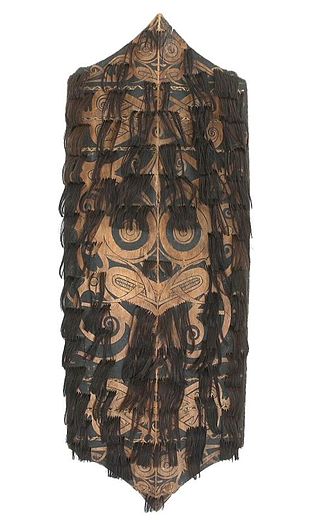
The Klebit Bok or Kelavit Bok is the traditional shield of the Kelabit, Kayan and the Kenyah people originating from Borneo. It is similar to the shields used by other Dayak people such as the Kliau of the Iban.

Parang Latok is a sword from Borneo in Sarawak, Malaysia; where it is regarded as the national weapon of the Sarawakian Malay people and the Bidayuhs, and as well as Kalimantan, Indonesia. It also functions as a machete.
Kancet Papatai is a traditional Indonesian war dance about a war hero and his struggle against the enemy. The dance also describes his courage and the ceremony awarding him the title Ajai, for his victory.
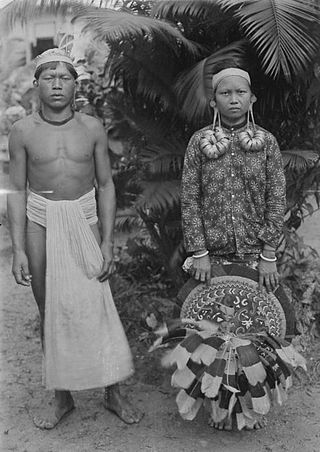
The Apo Kayan people are one of the Dayak people groups that are spread throughout Sarawak of Malaysia, East Kalimantan and North Kalimantan of Indonesia. The earliest Apo Kayan people are from the riverside of the Kayan River, Bulungan Regency, East Kalimantan, Indonesia. According to the Apo Kayan Dayak legend, the Kayan people are the forefathers of which all smaller sub-ethnic Dayak people that are found along the Kayan River came from. Today, the population of the Apo Kayan people are estimated about 64,900.

The Klemantan people were a purported ethnic group indigenous to the island of Borneo. The term was established in Western literature by British scientist and colonial administrator Charles Hose in the early 20th century, but has since been rejected as an invented term of convenience that does not properly represent the people it claims to describe. Since then, the term has fallen largely out of use.

Pisau raut is a whittling knife that is commonly as a tool to prepare the rattan and other fine carving found throughout the entire Malay archipelago. It is well known as an accompanying knife placed in the same sheath with the mandau, a traditional weapon of the Dayak people.

The keluri or keledi or enkulurai is a free reed gourd mouth organ from Sarawak, East Malaysia and Kalimantan made of bamboo and gourd. Historically the keledi or keluri was played by the Orang Ulu people who come from Sarawak, Malaysia, the area northwest of the island of Borneo. Among the Iban people the instrument is called enkulurai. Other peoples that have played the instrument include the Kayan people and Kenyah people. In the 21st century, the instrument has largely disappeared; while not extinct, researchers have had a difficult time finding anyone making or using the instruments.

The Dohong is a dagger or short war sword from Borneo. The name is used figuratively to imply bravery. In other parts of Borneo, it is simply referred to as Mandau. The Dohong is considered an ancient Dayak sword that was used long before the Mandau was introduced. It is believed to be the oldest weapon of the Dayak people. According to folklore, the first people who owns the Dohong are the forefathers of Dayak people, namely Raja Sangen, Raja Sangiang, and Raja Bunu.






















